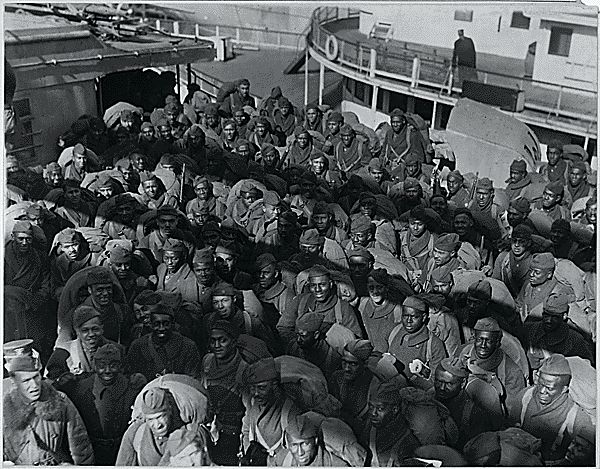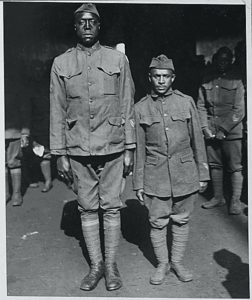Buffalo Soldiers
Black Soldiers in WW1
92nd & 93rd Divisions
Black soldiers in WW1 were referred to as “colored”. This designation appeared on all induction and discharge papers.
Black Infantry units in World War 1, adopted the name Buffalo soldiers, given to the black cavalry troops by the Indians in the 1880s.
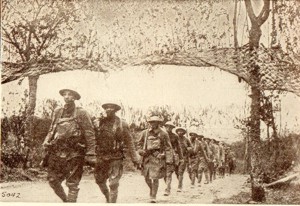
American Negro infantrymen advancing toward the front in the Argonne along a screened highway. It can truly be said of these American soldiers and their ilk in the campaign in France that ‘the colored troops fought nobly'”.
Photo and quotation from “America’s War for Humanity”
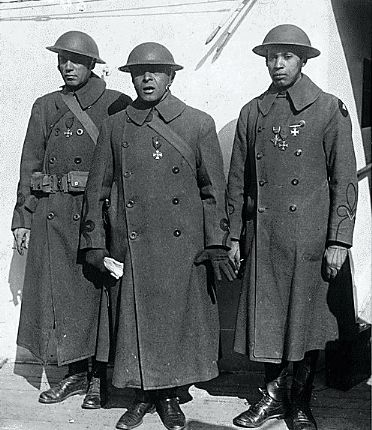
Officers of Famous [African American] Regiment which Arrived Home on the "France".
Left to right: Major J.R. White; Lieutenant Colonel Otis B. Duncan, highest ranking [African American] officer ...
National Archives Identifier: 533493 Local Identifier: 165-WW-127(9);
William Hayward, a white attorney from the Nebraska National Guard was appointed commander. Colonel Hayward hired both black and white officers had told them to the white officers to "Meet men according to their rank" If they were unable to do that they had no place with the 15th Infantry,
Hayward wanted his men to follow the usual military discipline and asked them to respond to racist insults with "fortitude and without retaliation" but to report any incidents to military authorities.
Haywood recruited bandleader James Reese Europe and requested he form a marching band. Classically trained violinists were merged with noted Harlem jazz and ragtime musicians. The troops numbered 2,000 and upon landing in France in January 1918 they surprised the French with their jazz rendition of "La Marseillaise".
The French were requesting American troops to replenish their depleted front lines. Pershing resisted, preferring to keep the American Expeditionary Forces intact. His compromise to placate the French was to assign the 369th Infantry that had been assigned manual labor duties such as unloading ships to latrine duty, to the French Infantry.
The 369th were in combat trenches after three weeks of training by the French and more than a month before the AEF, They manned the front lines and fought german raiding parties. Word of their bravery soon reached home. Headlines in the New York World read "Pershing Praises Brave Negros".
"For the Hellfighters, like the war’s millions of soldiers, front-line combat was a nightmare of shelling, fear of chemical-weapons attacks, and the terror of going “over the top” – charging out of the trenches to face enemy fire. “For two nights they gave us shell fire and the gas were thick and the forest looked like it were ready to give up all its trees every time a shell came crashing through,” wrote Horace Pippin, a private from Goshen, N.Y. who later became a prominent painter. “We barely knew what to do for we could not fight shells, but we could the Germans. We would rather face the Germans coming over the top than to have their shells.”
Just over two generations had passed between the start of WW1 and the Emancipation Proclamation abolishing slavery in the United States. Discrimination was still rampant. The US Army did not deem black soldiers able to handle the responsibilities of officers and most of the Pioneer Infantry sent to Europe were assigned to labor units in the back lines. The French saw this as a waste of talent and requested to utilize black soldiers within their forces. Many of the awards and distinctions achieved were granted by the French in gratitude for their services.
The United States declared war on Germany in April of 1917 with a standing army of only 126,000 men. A draft was passed in May of 1917 and all males between 21 and 31 were required to register. Within one week the quota for black volunteers was filled. Blacks were 10% of the total population but 13% of the inductees. The Commander of the 15th New York Infantry, Col. William Hayward asked to join the farewell parade for the 42nd Infantry, The Rainbow Division, and was reportedly told black was not a color of the Rainbow. The New York 69th Infantry went on the become the "Harlem Hell Fighters" and became the most celebrated African-American regiment in WW1.
Black soldiers fought in the Civil War. They were organized into the 24th & 25th Infantries and assigned white officers. The 9th and 10th Calvalry regiments had been retained and saw service in the Indian wars and all four units were active in the Spanish American War.
Blacks could not serve in the Marine Corps and initially would be assigned menial positions in the Navy and Coast Guard. By the end of WW1, they served in the infantry, cavalry, engineering, medical, signal, artillery units. They were also surveyors, truck drivers, chemists, chaplains, and intelligence officers.
They were not used in combat until a backlash from the African American community and ridicule from the French for not utilizing their talent resulted in the creation of the 92nd and 93rd Divisions as combat units, noted for their bravery and stood to confront racism.
Discrimination still persisted. White soldiers would often not salute black officers, and black officers were often barred from officers' clubs and quarters.
For more detailed information please see:
The 369th Infantry spent 191 days on the front lines, more than any other American troops.
144 were killed and over 1,000 wounded at the battle of Meuse-Argonne
Aaron R Fisher, Distinguished Service Cross
Gibson County Indiana:
Indiana War Memorial documentation:
Aaron R. Fisher of Lyles, Indiana, enlisted in the US Army in 1911 and had risen to the rank of Sergeant before leaving for Europe on June 15, 1918. Shortly after arriving in France, Fisher was commissioned 2nd Lieutenant in the 366th Infantry Regiment of the 92nd Division. The 92nd then entered the French lines near Lesseaux.
On September 3, Fisher displayed exceptional bravery in action when his position was attacked by a much larger German force. Despite being severely wounded in the initial onslaught, he refused to abandon his post, ordering his men to stand and fight. Although it appeared that they would quickly be overwhelmed, Fisher’s men fought against impossible odds until an Allied counterattack drove off the enemy.
Fisher was awarded the Distinguished Service Cross for what the U.S. Army called his “extraordinary heroism in action.” Furthermore, since Fisher’s brave stand was made in support of America’s French allies, the French bestowed upon him the Croix de Guerre, acknowledging him as “an officer of admirable courage.”
https://en.wikipedia.org/wiki/Aaron_R._Fisher
http://www.findagrave.com/cgi-bin/fg.cgi?page=gr&GRid=48482143
WW1 Black soldiers training with French Troops
War Heros
Gallant 15th Infantry Fighters on the way home with War Crosses.
The French liner, La France, arrives with 15th Infantry
the Negro fighters who won honors in France.
National Archives Photo
Eugene Bullitt Cheatham, US Calvary, 1st Lt., Marion County, Indiana
Served 14 months in the ninth US Calvary, 1893 –1894
“I am both White and Colored"
“Occupied front-line trenches with my Regiment – 372nd Infantry from June 5 to and including the 10th of September, 1918 in Argonne Forest and the Verdun sector, France.
Was Judge Advocate of 372nd Infantry from June to September 1918. Relieved from 372nd Infantry and assigned to Requisitions and Claims Service, September 1918. Remained in service until sent back to the United States and attached to Motor Battalion, 312th Ammunition Train, 87th Division, February 1919. Attached to and did duty with Demobilization Group, Camp Upton, New York from March 14, 1919, to July 21, 1919.”
George Robert Hazzard, Sergeant, Air Service, Marion County, Indiana
- 28th Co., 4th Batt., Air Service Aeronautics
- “First and the only colored unit given intensive air service training.”
- Trained at Ft. Wayne, Michigan & Mineola.
John Chester Smith, Private, Gold Star, Marion County, Indiana
Son of Charles and Maria Pettiford Smith; born February 2, 1897, Irvington, Marion County, Ind. Motor truck driver. Entered service September 25, 1918, Indianapolis, Ind. Trained at Camp Custer, Mich.; assigned to 3rd Provisional Company, Colored Detachment, 160th Depot Brigade. Died of pneumonia October 8, 1918, Camp Custer, Mich. Buried in Indianapolis, Ind.
Elisha Baker, Private, Gold Star, Marion County, Indiana
Son of Mitchell Thomas and Edith Belle Baker (both deceased); born November 18, 1891, Glasgow, Ky. Moved to Indianapolis, in 1902. Teamster. Entered service August 22, 1918, Indianapolis, Ind. Sent to Camp Dodge, Iowa; assigned to 65th Company, 163rd Depot Brigade; transferred to Company A, 809th Pioneer Infantry. Sailed overseas on September 23, 1918. Died of pneumonia October 8, 1918, Base Hospital, France. (Place of burial unknown).
Walter D. Baker, Corporal, Gold Star, Marion County, Indiana
Son of Mitchell Thomas and Edith Belle Baker (both deceased); born September 14, 1895, Glasgow, Ky. Moved to Indianapolis in 1904. Laborer. Entered service August 22, 1918, Indianapolis, Ind. Sent to Camp Dodge, Iowa; assigned to 26th Company, 7th Battalion, 163rd Depot Brigade; transferred to Company M, 809th Pioneer Infantry. Overseas on September 23, 1918. Died of psychosis dementia on September 8, 1919, in France. Buried “Somewhere in France.”
A section of "Hell Fighters from Harlem, 369th Infantry" that was commissioned by the US Army by Charles McBarron. The action depicted in the painting earned the Croix de Guerre for the entire regiment.
National Guard Heritage Painting, courtesy of the National Guard Bureau.
John Milton Lee, Bat. F., 349th Field Artillery, 92nd Div., Marion County, Indiana
While in position in Aton, France on October 21, 1918, about 10:25 p.m. I personally fired the first shot on enemy lines ever fired by a Colored artilleryman.
On the front continuously from October 19 to November 11, 1918. Occupied Marbache sector, attacked in direction of Corne, objective Metz.
Henry Spears, Private, Gold Star, Marion County, Indiana
Son of William and Jannie Spears; born December 12, 1896, Wilson, La. Farmer. Entered service June 14, 1918, in Indianapolis. Sent to Camp Taylor, Ky.; assigned to 70th Company, 18th Training Battalion, 159th Depot Brigade. Transferred to Camp Humphreys, Va.; assigned to Company B, 541st Engineers. Drowned August 25, 1918, Camp Humphreys, Va. Buried at Wilson, La.
Green H. Spencer, Mechanic, Gold Star, Marion County, Indiana
Son of Henry and Hannah Spencer; born November 14, 1886, Junction City, Boyle County, Ky. Moved to Indianapolis in May 1912. Laborer. Entered service July 10, 1918, Indianapolis. Sent to Camp Dodge, Iowa; assigned to 65th Company, 17th Training Battalion, 163rd Depot Brigade; transferred to Company K, 804th Pioneer Infantry. Went overseas on September 8, 1918. Died of pneumonia March 5, 1919, Gustinville, France. Place of burial, Gustinville, France.
Ezra H. Borah, Private, KIA, Marion County, Indiana
Son of Mr. and Mrs. John Borah; born March 28, 1890, Owensboro, Ky. Living in Indianapolis, Ind. when he entered service April 29, 1918. Overseas in July 1918; assigned to Company F, 368th Infantry. Killed in action September 27, 1918, in the battle of Argonne Forest. Buried in the Meuse-Argonne American Cemetery, France.
Eugene Taylor, Private, Gold Star, Marion County, Indiana
Indianapolis. Private, Company M, 809th Pioneer Infantry. Died of tuberculosis June 8, 1919, “Somewhere in France.”
William Robert Johnson, 809th Pioneer Infantry, Marion County, Indiana
Embarked for France, September 22, 1918, on USS Mongolia.
“Volunteered my services during the rage of the flu during our voyage at sea and was in full charge of all the officers who became ill during the 14-day trip, working day and night as a nurse.”
William J. Gregory, 809th Pioneer Infantry, Marion County, Indiana
Marbache sector: On February 12, a German mine exploded, seven men were torn into many pieces. I was knocked down was partially covered with the earth so I survived. Sent to first aid Station at Mars-la-Tours, France, the left ear was cut, several small cuts about-face and head.
Samuel Heater, Pvt., Gold Star, Marion County, Indiana
Son of William and Cleria Heater (both deceased); born May 3, 1890, Bowling Green, Ky. An employee of Indiana Foundry Company, Indianapolis. Entered service August 22, 1918, Indianapolis, Ind. Sent to Camp Dodge, Iowa. Transferred to Camp Upton, N. Y.; assigned to Company K, 809th Pioneer Infantry. Embarked October 1918, and died of influenza October 5, 1918, at sea. Survived by widow, Emma Heater, and daughter, Mattie Margaret, Indianapolis, Ind.
George Whitman Chatman, Pvt., Co. E., 370th Reg., 93rd Div., Marion County, Indiana
- Battles: Granville, May-June, 1918
- St. Mihiel, June 22 – July 2, 1918
- Argonne Sector, July 21 – August 15, 1918
- Antioch Farms, ( Soissons) September 17 – September 27, 1918
“I was in the 8th Illinois National Guard. After going to France, our Regiment was changed from the 8th Illinois to 370th Infantry. After arriving in France my Regiment was put into the French Division. We were in the 10th Army, French, and the 59th division, French. We remained in the French Division until December 8, 1918, then we came back to the 93rd Division, American.
After being in the hospital for about a month (gas wounds), I was sent back to my Regiment and we were fighting when the armistice was signed. After going into a French division, we went into French formation, which was three machine-gun companies to one Regiment, and three battalion headquarters. I was transferred from E. Co. to the 2nd Battalion Headquarters and served as Liaison.
I was reported missing in action in September, in the meantime, I had been gassed and taken up from the battlefield and sent back to a first aid station and from there to the hospital. It was not reported for a day or two that I have been gassed and sent to the hospital. Nevertheless, after getting all right again, I went back to my Regiment, and was fighting when the Germans cried, “Comrade.”
I remain yours sincerely,
George W. Chatman,823 Blake Street, Indianapolis, Indiana
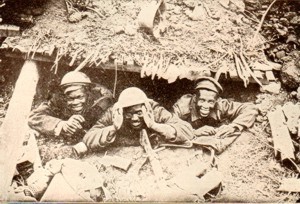
Stanley McCinty, Colored Canadian Expeditionary Forces, Marion County, Indiana
Served in the Canadian Construction Corps. Battles: Amiens, Ypres, Cambria, Arias
“Colored Canadians imitating the Germans that they captured in the dugout near the Canal du Nord, as they put up their hands and shouted ‘Kamerad.”
Canadian Official Photo, from the US, America’s War for Humanity
Paul Bennett, PFC, Heavy Artillery, 351st Regiment, 92nd Division, Marion County, Indiana
“I was discharged from the military in good physical condition with my character rated as excellent. My service record bore, no AWOL’s, no absences, in General Order 45, Washington DC, 1914. I served my entire enlistment with one of the best and only regiments of Heavy Field Artillery, Colored, that the world has known.”
Received an honorable mention from Major Field Commander, for successfully carrying messages between Field Headquarters to the trenches through shellfire. (Marbache Sector, Lorraine October 24 – November 11, 1918)
Additional information:
Pursuant to War Department Orders, the 92nd Division (1) was organized on November 29, 1917, from the first contingent of Negro draftees arriving at the various camps and cantonments throughout the United States during the latter part of the month of October 1917. The entire enlisted personnel was made up of Negroes and represented practically all the States in the Union. The Staff and Field Officers, officers of the Supply Units, Quartermaster Corps, Engineers’ Corps, and of the Artillery Units, with few exceptions, were white. The remainder of the commissioned personnel, comprising about four-fifths of the whole, were colored.
The plans of the War Department did not provide a separate cantonment for this division. It was therefore necessary to distribute its various units among seven widely-separated camps.
http://www.lib.byu.edu/~rdh/wwi/comment/Scott/SCh11.htm
Jerry Bostick, Private, Gold Star, Marion County, Indiana
Son of Rose and Sallie Bostick; born November 24, 1895, Nashville, Tenn. Came to Indianapolis August 18, 1916. Laborer. Entered service in June 1917, St. Louis, Mo. Trained at Camp Funston, Kans.; assigned to Company Ordnance Detachment, 317th Ammunition Regiment, Train Division 92. Died of pneumonia March 26, 1919, Hoboken, N. J. Buried in New Crown Hill Cemetery, Indianapolis, Ind. Survived by widow, Sarah Bostick, Indianapolis.
Charles Mentlow, Pvt., Gold Star, Marion County, Indiana
Son of Manual and Emma Mentlow (Young); born January 15, 1889, Cairo, Sumner County, Tenn. Came to Marion County, Ind. in 1913. Factory employee. Entered service April 29, 1918, Indianapolis, Ind. Sent to Camp Taylor, Ky.; assigned to Company A, 317th Labor Battalion. Overseas June 20, 1918. Died of pneumonia May 9, 1919, Hospital, Dijon, France. Buried in Cemetery No. 14, Dijon, Cote d’Or. Survived by widow, Lucy Wright Mentlow, Indianapolis, Ind.
Arthur Rogers Cline, 1st Lt., 809th Pioneer Infantry, Marion County, Indiana
“The 801st Pioneer Infantry arrived in France in the middle of September 1918. They were placed in the rear of fighting lines. They have been doing salvage work and are still in France.”
Bedford Crabtree, Sergeant, Co. C., 350th Machine-gun Battalion, Marion County, Indiana
St. Die, August 25 to September 20, 1918, Argonne Forest, September 26 to October 7, 1918, Marbache, October 8 to November 11, 1918.
Eugene T. Spering, Private, Gold Star, Marion County, Indiana
From Indianapolis, Indiana. Private. Company M, 809th Pioneer Infantry. Died of tuberculosis on June 8, 1919.
William Carter, Pvt. Gold Star, Marion County, Indiana
Son of Samuel and Della Carter; born May 28, 1918, Hancock County, Ky. Moved to Indianapolis in June 1915. Laborer. Entered service in August 1918, Indianapolis. Sent to Camp Dodge, Iowa. Assigned to 163rd Depot Brigade. Died of disease sometime in November 1918, at Camp Dodge. Buried in Military Cemetery, Camp Dodge, Iowa.
John Webster, Private, Gold Star, Marion County, Indiana
Son of Thomas and Louise Foster Webster; born December 11, 1890, Columbia, Tenn. Living in Indianapolis when he entered service May 14, 1918, Williamson, W. Va. Trained at Camp Lee, Va.; assigned to Company A, 320th Labor Battalion, Quartermaster Corps. Transferred to Company C, 316th Labor Battalion. Overseas September 15, 1918. Died of pneumonia December 21, 1918, Lievres-lor-cher, France. Buried, “Somewhere in France.”
Rufus Hill, Private, Gold Star, Marion County, Indiana
Beech Grove, Marion County, Ind. Private, 4th Provisional Company, 160th Depot Brigade. Died of influenza October 21, 1918, Camp Custer, Mich.
Mack House, Private, Gold Star, Marion County, Indiana
Indianapolis. Private, Company A, 414th Labor Battalion. Died of tuberculosis on June 10, 1919.
Mutt and Jeff" of Company "D," 505th Engineers on the Roma. The tallest and shortest members of the 505th [African American] Engineers that returned on the S.S. Roma. The tall one is Jesse Hixon of Pittsburg [Pennslyvania] and the short one Thomas C. Crispell of New Kingston, Pennslyvania.
Insignia of the 92nd Division
Indiana War Memorial Archives
The 92nd Div. was formed of “colored” soldiers from all states. This division advanced eight miles against enemy resistance, captured 38 prisoners, and lost 176 men with 1,466 wounded.
351st Field Artillery [African American] Troops on the Deck of the "Louisville." Part of the Squadron "A" 351st Field Artillery, African American troops who returned on the Transport Louisville...;
National Archives Photo
